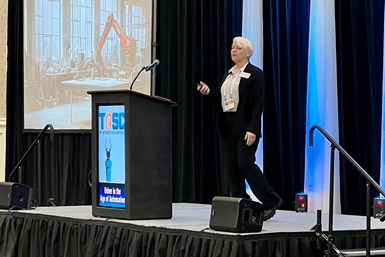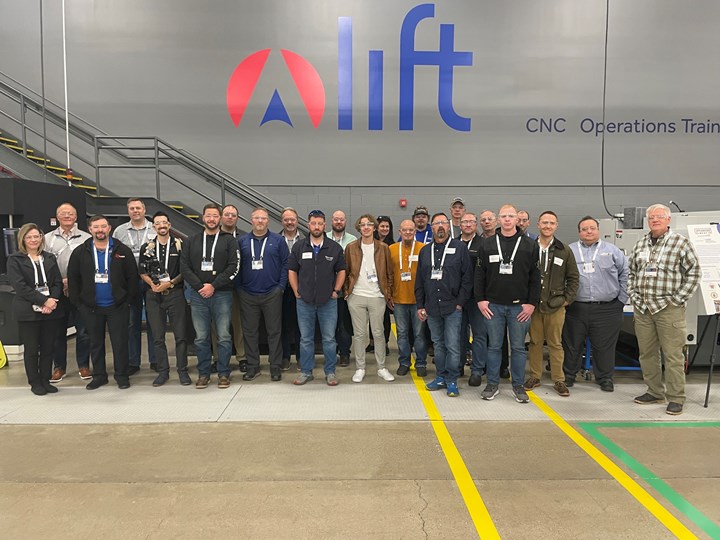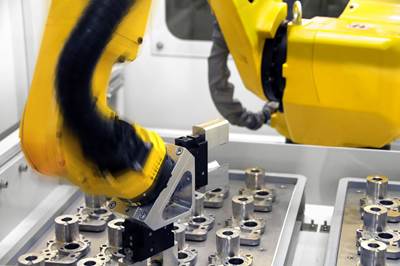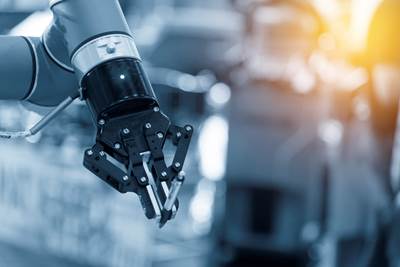Share


The inaugural edition of TASC – The Automated Shop Conference demonstrated three key facts about American job shops today: First, the only way that small- and mid-sized job shops can compete on cost with lower-wage countries is to increase production. Second, the key to increasing production is to automate shopfloor processes and equipment. And finally, one of the best ways that shop leaders can learn about new automation solutions is by relying on each other — the machining and metalworking community — to share automation strategies and tactics.
TASC, a conference from Gardner Business Media and Modern Machine Shop with the assistance from our friends at LAB / Midwest, was designed specifically for small-and medium-sized shop leaders. The event, which took place on Oct. 10 and 11 in Novi, Michigan, introduced attendees to 20 speakers whose specialties ranged from cobots to coolant to community college relations. While all shared a focus on shopfloor automation, their specialties shaped the different takeaways they offered to address the challenge of automating small and medium-sized job shops.

The skill to effectively utilize automation equipment is as important as the equipment itself. Andra Keay, VP of Global Robots at AMT and managing director of Silicon Valley Robotics, presented on ways to teach fresh (and seasoned) generations the skills they need to operate automated technology.
Understanding the Variables
“You have to understand a process before you can control it,” said Denis Vasilescu, industrial metrologist at Renishaw.
His words spoke to a common difficulty with automation implementation — it is always more involved than “plug-and-play.” Automation has a great power to repeat the task given to it, but this power is only a benefit so long as the process is successful. The process variables affecting an application can alter machining performance and cause unanticipated scrap, making their discovery and recognition vital for proper performance.
“For CNCs in particular, thermals are a variable that people tend to neglect or not think of very much,” Vasilescu offered. During his presentation, he brought up an anecdote about a shop that struggled to determine why one of its machines was significantly underperforming during the daytime hours — until staff realized that light from the windows shone directly onto the machine. One window shade later, and the problem resolved.
Rob Caron, president and CEO of Caron Engineering, also addressed process variables, but from a different angle. “The biggest one is the tooling itself,” he said. “When you’re cutting with cutting tools, there’s parameters and issues where things go wrong.”
To understand issues with parameters and tooling, Caron recommended the use of smart sensors to measure parts and provide insight into machining even when no staff members are on the floor. In some cases, these sensors can even prevent scrap by triggering emergency shutdowns when necessary.

In addition to the stage talks, TASC attendees could network with industry leaders and automation providers. Here, Denis Vasilescu presents Renishaw automation products to a small group after his talk.
Beyond Machine Tending
Robotic machine tending is a common application for shopfloor automation, but some of the TASC presentations addressed how shops can also realize massive improvements by automating less-obvious shop processes.
“Automating something like coolant, when you have such a manual process in place . . . it was a huge culture change for our shop,” says Brad Cisewski, applications coordinator at Pointe Precision. “It gives our operators more time to focus on the quality of our parts, giving our customers better parts. It allows our operators to do more tasks that take a lot more thinking.”
Cisewski also says the change has benefited shop morale: “There’s not a single person in our shop that would say ‘no, I liked it the old way.’ Nobody liked pushing around this 55-gallon drum. It was just an unnecessary evil that we had to do.”
Rather than focus on minimizing human labor through robotics, Dan Bagley, creator of the Athena digital assistant and CEO of Strategic Ink, spoke about the kinds of technologies that can augment human capabilities where robots aren’t feasible. “Find ways to use exoskeletons, augmented reality or virtual assistants,” he says. “These are several very in-reach technologies that can help workers do their jobs better on either side of the automation work, in the more bespoke work where judgment is involved.”
This strategy addresses a common shopfloor fear: that automation will lead to layoffs. Instead, as Bagley suggests, it leads to a shift in staff’s tasks. There are plenty of tasks on the shop floor where human judgment is required, and it is here that shops can redeploy staff for greater productivity, profits and employee satisfaction. Assistive technology then goes a step further than robots to give shopfloor staff tools to easier complete these tasks.
The Full ROI Picture
Many speakers at the conference tied robots to the need to increase labor productivity, which lowers costs per part and better enables shops to be competitive in the automation age. But these cost savings were just the beginning of what speakers discussed.
Cisewski touched on this point, too: By removing the need for staff to manually distribute and change coolant, shopfloor morale improved in his shop and staff can work on more engaging jobs — the same sort of benefits Bagley predicted.
Robby Komljenovic, chairman and CEO of Acieta, expanded on these benefits: “It is not just labor savings, it’s also labor retention, attraction, quality, and then — of course — productivity. You have to look at your total return of investment justification.” During Komljenovic’s presentation, he contextualized this with an example of palletization. He pointed out that palletization is not just a lengthy task, but a physically strenuous job, too. Automating it not only saves time for the shop and frees up the operator to carry out another task, it removes the risk of back strain and injury. This improves the operator’s quality of life, and simultaneously, their satisfaction in their job.

TASC attendees also had the chance to visit FANUC’s Detroit production facility and a facility of LIFT, a public-private “accelerator” that develops talent, showcases advanced manufacturing technology and tests new materials and processes to advance American manufacturing. Image courtesy of LIFT.
TASC Update
From cobots to exoskeletons to coolant automation technology, automation and assistive technology will only continue to grow in importance over the next decade. Equally important will be the chance to gain advice directly from technical presenters knowledgeable in what’s new, advanced and unexpected in the field. TASC will return in 2024 to provide this opportunity as a co-located show with IMTS.
Related Content
10 Robotic Solutions You Can Find at IMTS 2026
Discover how today’s robots and cobots are making it easier than ever to automate tasks, free up skilled workers, and run machines unattended – even in small and midsized shops.
Read MoreEmbracing Automation: Strategies for Small to Medium-Sized Machine Shops
Business drivers for automating to help navigate workforce challenges and boost profitability.
Read MoreAutomation is for Everyone
Not just for large shops, automation can help even the smallest shops solve labor challenges and become more profitable and efficient.
Read More4 Manufacturing Trends That Cannot Be Ignored
The next five years will present their own unique set of challenges, and shops can alleviate them by embracing these technologies and trends.
Read MoreRead Next
3 TASC Topics That Touch on Automation Considerations for Job Shops
Automation is no longer a luxury in manufacturing today – it’s a necessity. The Automated Shop Conference (TASC) will connect job shops with experts who offer advice and considerations for this process.
Read MoreLessons on the Journey Toward Shop Automation
By necessity, small and mid-sized American job shops are automating production, whether through swift, dramatic upgrades in capital equipment, or slow, methodical changes to processes and procedures on the shop floor.
Read More4 Lessons Your Shop Will Take Away From TASC
The Automated Shop Conference (TASC) will give shops of all sizes and production volumes key insights and practical guidance on how to implement automation.
Read More






























